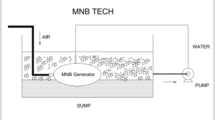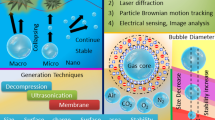Abstract
The distinctive properties of nanobubbles (< 200 nm in diameter) attributed their use in many engineering fields. This paper enumerates the simplest method for generation of nanobubbles in different aqueous solutions with their practical applications. Tap water, distilled water, slurry water and sea water with and without the presence of nanobubbles were tested for chemical oxygen demand, biochemical oxygen demand, total suspended solids, total dissolved solids, dissolved oxygen, nitrate, phosphate, chromium and sulphide level. Measurement of size of nanobubbles by atomic force microscopy, measurement of density, viscosity, laser beam width and time taken for heating and cooling of aqueous solutions with and without the presence of nanobubbles were also presented in this experimental investigation. In the presence of nanobubbles, the porous nature of the material increases drastically so the original properties of the material changes. While the density of the material changes, its fluidity and other properties were changed. The presence and absence of nanobubbles influence drastic changes in properties of the chosen samples and hence different samples were examined. The result we obtained was good agreement of the previous results especially density and temperature variation in nanobubbles water. Tested nanobubbles aqueous solutions were applied for aquaculture, germination of green pulses and washing of utensils and the results are highlighted.











Similar content being viewed by others
References
Alghannam AF (2012) Metabolic limitations of performance and fatigue in football. J Can Res Updates 4(2):65–73
Azevedo A, Etchepare R, Calgaroto S, Rubio J (2016) Aqueous dispersions of nanobubbles: generation, properties and features. Miner Eng 94:2937
Ebina K, Shi K, Hirao M, Hashimoto J, Kawato Y, Kaneshiro S, Morimoto T, Koizumi K, Yoshikawa H (2013) Oxygen and air nanobubble water solution promote the growth of plants, fishes, and mice. PLoS One 8:e65339
Gurung A, Dahl O, Jansson K (2016) The fundamental phenomena of nanobubbles and their behaviour in wastewater treatment technologies. Geosyst Eng. https://doi.org/10.1080/12269328.2016.1153987
Hampton MA, Nguyen AV (2010) Nanobubbles and the nanobubble bridging capillary force. Adv Coll Interface Sci 154:30–55
Ishida N, Inoue T, Miyahara M, Higashitani K (2000) Nano bubbles on a hydrophobic surface in water observed by tapping-mode atomic force microscopy. Langmuir 16:6377–6380
Lvov YM, Pattekari P, Zhang X, Torchilin V (2011) Converting poorly soluble materials into stable aqueous nanocolloids. Langmuir 27(3):1212–1217
Minamikawa K et al (2015) Irrigation with oxygen-nanobubble water can reduce methane emission and arsenic dissolution in a flooded rice paddy. Environ Res Lett 10:084012
Mozaffar S, Tchoukov P, Mozaffar A, Atias J, Czarnecki J, Nazemifar N (2017) Capillary diven flow in nanochannels—application to heavy oil rheology studies. Coll Surf A Physiochem Eng Asp 513(5):178–187
Mozaffari S, Tchoukov P, Atias J, Czarnecki J, Nazemifard N (2015) Effect of asphaltene aggregation on rheological properties of diluted athabasca bitumen. Energy Fuels 29(9):5595–5599
Pattekari P, Zheng Z, Zhang X, Levchenko T, Torchilin V, Lvov Y (2011) Top-down and bottom–up approaches in production of aqueous nanocolloids of low solubility drug paclitaxel. Phys Chem Chem Phys 13(19):9014–9019
Rajib MM, Farzeen P, Ali M (2017) Study on the number density of nanobubbles at varying concentration of ethanol in ethanol-water solution. In: AIP conference proceedings. AIP Publishing, Melville
Ushida A, Hasegawa T, Narumi T, Nakajima T (2013) Flow properties of nanobubble mixtures passing through micro-orifices. Int J Heat Fluid Flow 40:106–115
Vajjha RS, Das DK (2008) Measurements of specific heat and density of Al2O3 Nanofluid. In: Mesoscopic, nanoscopic and macroscopic materials: Proceedings of the International Workshop on Mesoscopic, Nanoscopic and Macroscopic Materials (IWMNMM-2008). AIP Publishing, Melville, pp 361–370
Vergara D, Bellomo C, Zhang X, Vergaro V, Tinelli A, Lorusso V, Rinaldi R, Lvov YM, Leporatti S, Maffia M (2012) Lapatinib/Paclitaxel polyelectrolyte nanocapsules for overcoming multidrug resistance in ovarian cancer. Nanomed NBM 8(6):891–899
Vergaro V, Scarlino F, Bellomo C, Rinaldi R, Vergara D, Maffia M, Baldassarre F, Giannelli G, Zhang X, Lvov YM, Leporatti S (2011) Drug-loaded polyelectrolyte microcapsules for sustained targeting of cancer cells. Adv Drug Deliv Rev 63(9):847–864
Wu H, Rognin NG, Krupka TM, Solorio L, Yoshiara H, Guenette G, Sanders C, Kamiyama N, Exner AA (2013) Acoustic characterization and pharmacokinetic analyses of new nanobubble ultrasound contrast agents. Ultrasound Med Biol 39:2137–2146
Yang CW, Luand Y-H, Hwang I-S (2013) Imaging surface nanobubbles at graphite–water interfaces with different atomic force microscopy modes. J Phys Condens Matter 25:18
Yiamsawas T, Dalkilic AS, Mahian O, Wongwises S (2013) Measurement and correlation of the viscosity of water-based Al2O3 and TiO2 nanofluids in high temperatures and comparisons with literature reports. J Dispers Sci Technol 34:1697–1703
Zhang XH, Maeda N, Craig VSJ (2006) Physical properties of nanobubbles on hydrophobic surfaces in water and aqueous solutions. Langmuir 22:5025–5035
Zheng Z, Zhang X, Carbo D, Clark C, Nathan C-A, Lvov Y (2010) Sonication-assisted synthesis of polyelectrolyte-coated curcumin. Nanopart Langmuir 26(11):7679–7681
Author information
Authors and Affiliations
Corresponding author
Additional information
Publisher’s Note
Springer Nature remains neutral with regard to jurisdictional claims in published maps and institutional affiliations.
Rights and permissions
About this article
Cite this article
Senthilkumar, G., Rameshkumar, C., Nikhil, M.N.V.S. et al. An investigation of nanobubbles in aqueous solutions for various applications. Appl Nanosci 8, 1557–1567 (2018). https://doi.org/10.1007/s13204-018-0831-8
Received:
Accepted:
Published:
Issue Date:
DOI: https://doi.org/10.1007/s13204-018-0831-8




